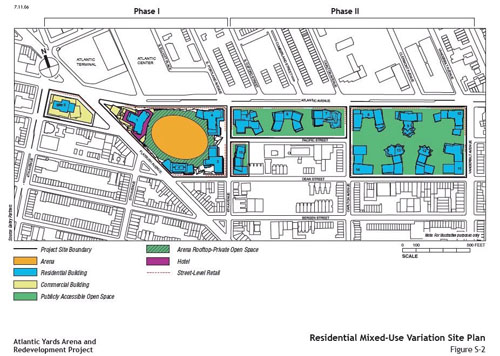More About Atlantic Yards Impacts and Problems

A number of organizations and individuals have been doing heroic work dissecting the huge Atlantic Yards Draft Environmental Impact Statement that will be the subject of a public hearing tomorrow night. One major theme has already emerged: As massive as the document is, the consultants that prepared seem to have seriously skewed their analysis to ignore very significant impacts the big project at Atlantic and Flatbush avenues will have on Brooklyn (or to, at least, underestimate some very unpleasant impacts).
Both Develop Don't Destroy Brooklyn and the consultants hired by the Council of Brooklyn Neighborhoods (CBN) point out that New York City's own zoning prohibits an arena within 200 feet of a residential district. The reason, as noted by DDDB: "some of the operations could be incompatible with districts limited primarily to residential use." According to the consultants commissioned by the CBN, whose critiques are extensively referenced in Norman Oder's Atlantic Yard's Report:
In order to understand the true effect of an urban arena, other examples from different cities should be referenced in the DEIS. Based on preliminary analysis, there are no urban arenas 200 ft or less from residential neighborhoods that are positive examples.Of course, having the ability to skirt NYC zoning, city regulations and the local review process could be among the reasons that the project was turned over to the Empire State Development Corporation.
Meanwhile, some of the conclusions of the CBN's consultants make for very compelling reading about the very selective and skewed nature of the Draft Environmental Impact Statement that will be the subject of tomorrow's public hearing. (Read their latest bulletin, released yesterday, here.) For a very chilling example of why the DEIS could allege such minimal impacts from the project, consider the following:
The DEIS assumes less than half (47%) of the development that is underway or approved in the study area, resulting in an underestimation of all impacts, dramatically under-reporting traffic and transit impacts and virtually all issues....In general, traffic volumes for baseline 2006 appear lower than reported for 2002 for the Downtown Brooklyn Redevelopment Plan EIS. This seems like an underestimation of impact.If ever there were a project that needed a full public examination and a local review process, Atlantic Yards is it.

0 Comments:
Post a Comment
<< Home